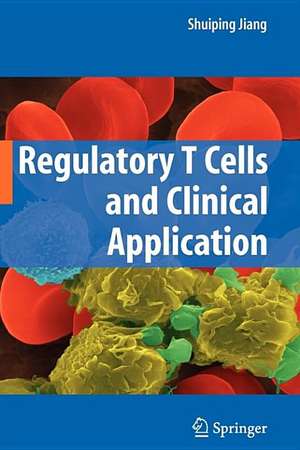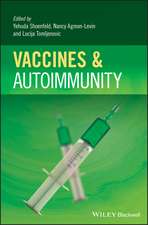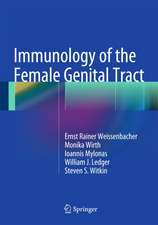Regulatory T Cells and Clinical Application
Editat de Shuiping Jiangen Limba Engleză Paperback – 6 dec 2010
| Toate formatele și edițiile | Preț | Express |
|---|---|---|
| Paperback (1) | 1016.07 lei 38-44 zile | |
| Springer – 6 dec 2010 | 1016.07 lei 38-44 zile | |
| Hardback (1) | 1021.76 lei 38-44 zile | |
| Springer – 6 oct 2008 | 1021.76 lei 38-44 zile |
Preț: 1016.07 lei
Preț vechi: 1069.55 lei
-5% Nou
Puncte Express: 1524
Preț estimativ în valută:
194.42€ • 203.54$ • 160.87£
194.42€ • 203.54$ • 160.87£
Carte tipărită la comandă
Livrare economică 01-07 aprilie
Preluare comenzi: 021 569.72.76
Specificații
ISBN-13: 9781441926708
ISBN-10: 1441926704
Pagini: 624
Ilustrații: XVIII, 590 p. 71 illus., 32 illus. in color.
Dimensiuni: 155 x 235 x 37 mm
Greutate: 0.9 kg
Ediția:Softcover reprint of hardcover 1st ed. 2008
Editura: Springer
Colecția Springer
Locul publicării:New York, NY, United States
ISBN-10: 1441926704
Pagini: 624
Ilustrații: XVIII, 590 p. 71 illus., 32 illus. in color.
Dimensiuni: 155 x 235 x 37 mm
Greutate: 0.9 kg
Ediția:Softcover reprint of hardcover 1st ed. 2008
Editura: Springer
Colecția Springer
Locul publicării:New York, NY, United States
Public țintă
Professional/practitionerCuprins
Immunobiology of Regulatory T Cells.- Regulatory T Cells and the Control of Auto-Immunity: From day 3 Thymectomy to FoxP3+ Regulatory T Cells.- FoxP3 and Regulatory T Cells.- Thymic and Peripheral Generation of CD4 + Foxp3 + Regulatory T Cells.- The Role of IL-2 in the Development and Peripheral Homeostasis of Naturally Occurring CD4 + CD25 + Foxp3 + Regulatory T Cells.- IL-2 Signaling and CD4+ CD25+ Regulatory T Cells.- TGF-Beta and Regulatory T Cells.- TGF-? Regulates Reciprocal Differentiation of CD4 + CD25 + Foxp3 + Regulatory T Cells and IL-17-Producing Th17 Cells from Naïve CD4 + CD25 – T Cells.- Molecular Signalling in T Regulatory Cells.- Regulatory T Cells in Disease and Clinical Application.- CD4+Foxp3+Regulatory T Cells in Immune Tolerance.- Regulatory T Cell Control of Autoimmune Diabetes and Their Potential Therapeutic Application.- CD4+CD25+ Regulatory T Cells as Adoptive Cell Therapy for Autoimmune Disease and for the Treatment of Graft-Versus-Host Disease.- Natural CD4 + CD25 + Regulatory T Cells in Regulation of Autoimmune Disease.- Multiple Sclerosis and Regulatory T Cells.- CD4+CD25+ Regulatory T Cells and TGF-Beta in Mucosal Inflammation.- Induction of Adaptive CD4+CD25+Foxp3+ Regulatory T Cell Response in Autoimmune Disease.- Regulatory T Cells in Transplantation.- Regulatory T-cells in Therapeutic Transplantation Tolerance.- CD4 + CD25 + Regulatory T Cell Therapy for the Induction of Clinical Transplantation Tolerance.- Regulatory T Cells in Allergic Disease.- Regulatory T Cells and Tumour Immunotherapy.- Regulatory T Cells in Hepatitis and Hepatocellular Carcinoma.- CD4+CD25+ Regulatory T Cells in Viral Infections.- IL-10 and TGF-?-Producing Regulatory T Cells in Infection.- Human Type 1 T Regulatory Cells.- CD8+ T Regulatory Cells inEye Derive Tolerance.- Immune Suppression by a Novel Population of CD8??+TCR??+ Regulatory T cells.- Innate Regulatory iNKT Cells.- Natural Killer T Cells Regulate the Development of Asthma.- The Development, Activation, Function and Mechanisms of Immunosuppressive Double Negative (DN) T Cells.- ?? T Cells in Immunoregulation.
Textul de pe ultima copertă
A major process of rediscovery has taken place in the field of Cellular Immunology over the past 12 years—subsets of T lymphocytes exist that are specifically dedicated to regulation or as it should be more appropriately termed suppression of all aspects of immune responses.
It was only after Prof. Sakaguchi identified the CD25 antigen in 1995 as a marker for a major population of T cells that had suppressor functions both in vitro and in vivo that the resurgence in the regulatory T cell area could begin.
The regulatory T cells field has grown dramatically over the past decade. It is now impossible to read a journal that does not contain numerous papers whose titles deal with regulatory T cells. More importantly, it is also difficult to submit a new research grant proposal in any area of immunologic research that does not include a section on analysis on the contribution of regulatory T cells to the subject matter under study.
Regulatory T cells can be best thought of today as "teenagers" ready to take on all the challenges of complex immune responses. In ten years, the field will certainly be more mature, and manipulation of regulatory T cell function by cellular biotherapy, antibodies and small molecules will be routine function of the clinical immunologist.
- From Preface by Prof. Ethan Shevach, National Institute of Health, USA
It has been for long debated whether suppressor/regulatory T cells did actually even exist. Today, this question is no longer accurate and the subject of regulatory T cells is the object of a constantly growing interest in immunologists and clinicians. There is no doubt that the history of Tregs will make a new big leap ahead.
- From Chapter One by Prof. Shimon Sakaguchi, Kyoto University, Japan
It was only after Prof. Sakaguchi identified the CD25 antigen in 1995 as a marker for a major population of T cells that had suppressor functions both in vitro and in vivo that the resurgence in the regulatory T cell area could begin.
The regulatory T cells field has grown dramatically over the past decade. It is now impossible to read a journal that does not contain numerous papers whose titles deal with regulatory T cells. More importantly, it is also difficult to submit a new research grant proposal in any area of immunologic research that does not include a section on analysis on the contribution of regulatory T cells to the subject matter under study.
Regulatory T cells can be best thought of today as "teenagers" ready to take on all the challenges of complex immune responses. In ten years, the field will certainly be more mature, and manipulation of regulatory T cell function by cellular biotherapy, antibodies and small molecules will be routine function of the clinical immunologist.
- From Preface by Prof. Ethan Shevach, National Institute of Health, USA
It has been for long debated whether suppressor/regulatory T cells did actually even exist. Today, this question is no longer accurate and the subject of regulatory T cells is the object of a constantly growing interest in immunologists and clinicians. There is no doubt that the history of Tregs will make a new big leap ahead.
- From Chapter One by Prof. Shimon Sakaguchi, Kyoto University, Japan
Caracteristici
Covers one of the hottest topics in immunology today Compiles recent developments in T cell immunobiology and clinical applications Will have broad appeal to both researchers and clinicians Includes supplementary material: sn.pub/extras











